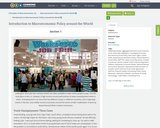1055 Results

14. Brave New World: Privacy, Data Sharing and Evidence Based Policy Making
The trifecta of globalization, urbanization and digitization have created new opportunities and challenges across our nation, cities, boroughs and urban centers. Cities in particular are in a unique position at the center of commerce and technology becoming hubs for innovation and practical application of emerging technology. In this rapidly changing 24/7 digitized world, governments are leveraging innovation and technology to become more effective, efficient, transparent and to be able to better plan for and anticipate the needs of its citizens, businesses and community organizations. This class will provide the framework for how cities and communities can become smarter and more accessible with technology and more connected.
- Subject:
- Business and Communication
- Management
- Material Type:
- Lesson
- Provider:
- CUNY Academic Works
- Provider Set:
- Medgar Evers College
- Author:
- Rhonda S. Binda
- Date Added:
- 10/30/2020

In this project, you will explore a real-world problem, and then work through a series of steps to analyze that problem, research ways the problem could be solved, then propose a possible solution to that problem. Often, there are no specific right or wrong solutions, but sometimes one particular solution may be better than others. The key is making sure you fully understand the problem, have researched some possible solutions, and have proposed the solution that you can support with information / evidence.Begin by reading the problem statement in Step 1. Take the time to review all the information provided in the statement, including exploring the websites, videos and / or articles that are linked. Then work on steps 2 through 8 to complete this problem-based learning experience.
- Subject:
- Composition and Rhetoric
- Elementary Education
- Material Type:
- Lesson Plan
- Author:
- Tracy Rains
- Date Added:
- 01/29/2018

Word Count: 78647
(Note: This resource's metadata has been created automatically by reformatting and/or combining the information that the author initially provided as part of a bulk import process.)
- Subject:
- Agriculture
- Applied Science
- Business and Communication
- Career and Technical Education
- Economics
- Education
- Engineering
- Finance
- Management
- Social Science
- Sociology
- Material Type:
- Textbook
- Provider:
- Pressbooks
- Date Added:
- 01/26/2024
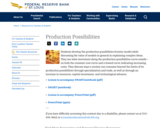
Students develop the production possibilities frontier model while discussing the value of models in general in explaining complex ideas. They see what movement along the production possibilities curve entails on both the constant-cost curve and a bowed curve indicating increasing costs. They discuss ways a society can consume beyond the limits of its production possibilities through specialization and trade, as well as through an increase in resources, capital investment, and technological advance.
- Subject:
- Economics
- Social Science
- Material Type:
- Lesson
- Lesson Plan
- Provider:
- Federal Reserve Bank of St. Louis
- Provider Set:
- Economic Lowdown Lessons
- Author:
- Barbara Flowers
- Date Added:
- 10/06/2014
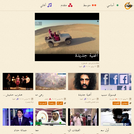
Mumkin offers practice materials for learners who are at a beginning, intermediate, and advanced level. Materials are grouped by difficulty level, and consists of videos in Arabic daily life followed by comprehension questions in the form of multiple choice or fill in the blank questions. Users also have the ability to read an Arabic transcription of each video. The site also provides a series of songs in Arabic that depict some aspect of contemporary Arab life along with the lyrics to the songs.
- Subject:
- Arts and Humanities
- Languages
- World Cultures
- Material Type:
- Activity/Lab
- Interactive
- Reading
- Provider:
- Mumkin
- Date Added:
- 10/14/2013
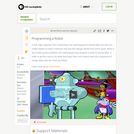
In this video segment from Cyberchase, the CyberSquad breaks down an action into a series of steps in order to program a robot to do what they need it to do.
- Subject:
- Applied Science
- Computer Science
- Computing and Information
- Engineering
- Geometry
- Mathematics
- Physical Science
- Physics
- Technology
- Material Type:
- Lecture
- Provider:
- PBS LearningMedia
- Provider Set:
- PBS Learning Media: Multimedia Resources for the Classroom and Professional Development
- Author:
- The William and Flora Hewlett Foundation
- WNET
- Date Added:
- 08/29/2008
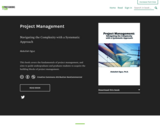
The world has become more complicated with the introduction and development of new technologies and methods, and novel risks such as Covid-19 pandemic. Competition has been tougher than it used to be. Organizations strive to keep up with the changes in the internal and external environment. In the light of unprecedented changes, project managers must be prepared in response to the demands from their organizations and key stakeholders like clients, customers and government agencies. This book covers the fundamentals of project management, and aims to guide undergraduate and graduate students to acquire the building blocks of project management. This book also includes Microsoft Project tutorials for project scope, schedule, resources, and cost, and monitoring and controlling.
- Subject:
- Business and Communication
- Material Type:
- Textbook
- Provider:
- MSL Academic Endeavors
- Author:
- Abdullah Oguz
- Date Added:
- 10/27/2022

This is a culminating activity for the MMS Mission Educator's Instructional Guide. Learners should complete the four previous activities in the guide before moving to this activity. Learners will choose and complete three activities about the MMS mission. Activity formats can include creating videos, composing songs, developing written materials, constructing models, investigating current events, utilizing mathematics to explain concepts, and more. Depending on the project(s) chosen by a student, the project activity may require student access to internet accessible computers. This is lesson five as part of the MMS Mission Educator's Instructional Guide.
- Subject:
- Applied Science
- Engineering
- Technology
- Material Type:
- Activity/Lab
- Assessment
- Data Set
- Diagram/Illustration
- Game
- Lecture Notes
- Lesson Plan
- Provider:
- NASA
- Provider Set:
- NASA Wavelength
- Date Added:
- 11/05/2014
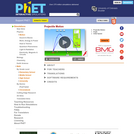
Blast a Buick out of a cannon! Learn about projectile motion by firing various objects. Set the angle, initial speed, and mass. Add air resistance. Make a game out of this simulation by trying to hit a target.
- Subject:
- Physical Science
- Physics
- Material Type:
- Simulation
- Provider:
- University of Colorado Boulder
- Provider Set:
- PhET Interactive Simulations
- Author:
- Michael Dubson
- Wendy Adams
- Date Added:
- 04/07/2006
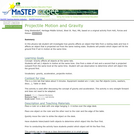
This activity is a mini lab where students see the effects of gravity on objects falling from a resting state and objects projected out from the same level.
- Subject:
- Physical Science
- Physics
- Material Type:
- Activity/Lab
- Provider:
- Science Education Resource Center (SERC) at Carleton College
- Provider Set:
- Pedagogy in Action
- Author:
- Gregory Westendorf
- Date Added:
- 08/10/2012
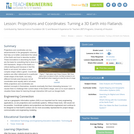
Projections and coordinates are key advancements in the geographic sciences that allow us to better understand the nature of the Earth and how to describe location. These innovations in describing the Earth are the basis for everything that is done in a GIS framework. Shape of the Earth is a critical starting point because in fact the Earth is not round but rather a more complex shape called a geoid. Coordinate systems are often referenced to a particular model shape of the Earth, but many different formats exist because not all coordinates work equally well in all areas. While projections and coordinates are abstract concepts in themselves, students eventually find them interesting because 1) it causes them to challenge their current ideas of the Earth's shape and 2) it is much easier to visualize these ideas for learning through interactive GIS such as Google Earth.
- Subject:
- Applied Science
- Engineering
- Geoscience
- Physical Science
- Space Science
- Technology
- Material Type:
- Lesson Plan
- Provider:
- TeachEngineering
- Provider Set:
- TeachEngineering
- Author:
- Andrey Koptelov
- Nathan Howell
- Date Added:
- 09/18/2014

This resource is a video abstract of a research paper created by Research Square on behalf of its authors. It provides a synopsis that's easy to understand, and can be used to introduce the topics it covers to students, researchers, and the general public. The video's transcript is also provided in full, with a portion provided below for preview:
"In 2015, the United Nations laid out 17 Sustainable Development Goals for the world. The goals aim to improve the lives of millions through actions such as ending poverty, protecting the planet, and assuring prosperity for all. Their success, however, depends on whether leaders can effectively mobilize to meet them. A team of researchers argues that this mobilization is unlikely without greater focus on implementing the goals in an integrated way. Finding connections among means of implementation, they say, will avoid wasted efforts and maximize efficiency. One of the biggest risks in overlooking these connections is contradictory efforts. Boosting industrial output, for example, could reduce the availability of clean drinking water. In this case, working towards one goal makes it harder to meet another. By understanding these connections between goals, however, leaders can tackle one target in a way that benefits many others..."
The rest of the transcript, along with a link to the research itself, is available on the resource itself.
- Subject:
- Atmospheric Science
- Physical Science
- Material Type:
- Diagram/Illustration
- Reading
- Provider:
- Research Square
- Provider Set:
- Video Bytes
- Date Added:
- 09/20/2019
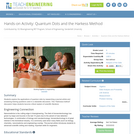
Students explore the applications of quantum dots by researching a journal article and answering framing questions used in a classwide discussion. This "Harkness-method" discussion helps students become critical readers of scientific literature.
- Subject:
- Applied Science
- Engineering
- Life Science
- Technology
- Material Type:
- Activity/Lab
- Provider:
- TeachEngineering
- Provider Set:
- TeachEngineering
- Author:
- Amber Spolarich
- Date Added:
- 09/18/2014
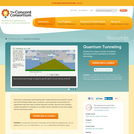
Delve into a microscopic world working with models that show how electron waves can tunnel through certain types of barriers. Learn about the novel devices and apparatuses that have been invented using this concept. Discover how tunneling makes it possible for computers to run faster and for scientists to look more deeply into the microscopic world.
- Subject:
- Applied Science
- Engineering
- Material Type:
- Activity/Lab
- Data Set
- Interactive
- Lecture Notes
- Provider:
- Concord Consortium
- Provider Set:
- Concord Consortium Collection
- Author:
- The Concord Consortium
- Date Added:
- 12/11/2011
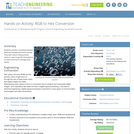
Students practice converting between RGB and hexadecimal (hex) formats. They learn about mixing primary colors in order to get the full spectrum of colors and how to average pixel values.
- Subject:
- Applied Science
- Engineering
- Technology
- Material Type:
- Activity/Lab
- Provider:
- TeachEngineering
- Provider Set:
- TeachEngineering
- Author:
- Anna Goncharova
- Date Added:
- 09/18/2014

This is the Justice Department's Radiation Exposure Compensation Program homepage. This site features information about the Radiation Exposure Compensation Act, including claimant categories, claim forms, and the Energy Employees Occupational Illness Compensation Program Act. This site also provides a table illustrating a summary of all claims received and compensation paid to date.
- Subject:
- Applied Science
- General Law
- History
- History, Law, Politics
- Law
- Technology
- Material Type:
- Reading
- Provider:
- Science Education Resource Center (SERC) at Carleton College
- Provider Set:
- Teach the Earth
- Author:
- U.S. Department of Justice Radiation Exposure Compensation Program
- Date Added:
- 11/07/2014
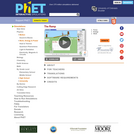
Explore forces, energy and work as you push household objects up and down a ramp. Lower and raise the ramp to see how the angle of inclination affects the parallel forces acting on the file cabinet. Graphs show forces, energy and work.
- Subject:
- Physical Science
- Physics
- Material Type:
- Simulation
- Provider:
- University of Colorado Boulder
- Provider Set:
- PhET Interactive Simulations
- Author:
- Carl Wieman
- Danielle Harlow
- Kathy Perkins
- Sam Reid
- Trish Loeblein
- Wendy Adams
- Date Added:
- 10/05/2006

In this course students will visit the past through cookbooks to learn about what foodstuffs and technologies were available and when, and how religious and nutritional concerns dictated what was eaten and how it was cooked. Students will also learn about the gender dynamics of culinary writing and performances and the roles people played in writing and cooking recipes.
- Subject:
- Arts and Humanities
- Gender and Sexuality Studies
- History
- Literature
- Social Science
- Sociology
- Material Type:
- Full Course
- Provider Set:
- MIT OpenCourseWare
- Author:
- Lipkowitz, Ina
- Date Added:
- 02/01/2017
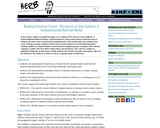
In this activity, students are guided through a close reading of The Journal of Sean Sullivan: A Transcontinental Railroad Worker, a fictional book for young readers based on historical sources. Students will read a short excerpt from the beginning of the book and determine the meaning of key words. Working in groups, students will then read excerpts related to one of the following themes: working conditions of railroad builders; tension between immigrant groups; corruption of the railroad companies; conflict with Great Plains Indian tribes; and boomtowns. They will also complete an individual writing task on their theme. Finally, students will consider the positive and negative effects of the railroad on the country as a whole, as well as on specific groups of Americans.
- Subject:
- History
- U.S. History
- Material Type:
- Activity/Lab
- Provider:
- City University of New York
- Provider Set:
- Social History for Every Classroom
- Date Added:
- 11/21/2019
